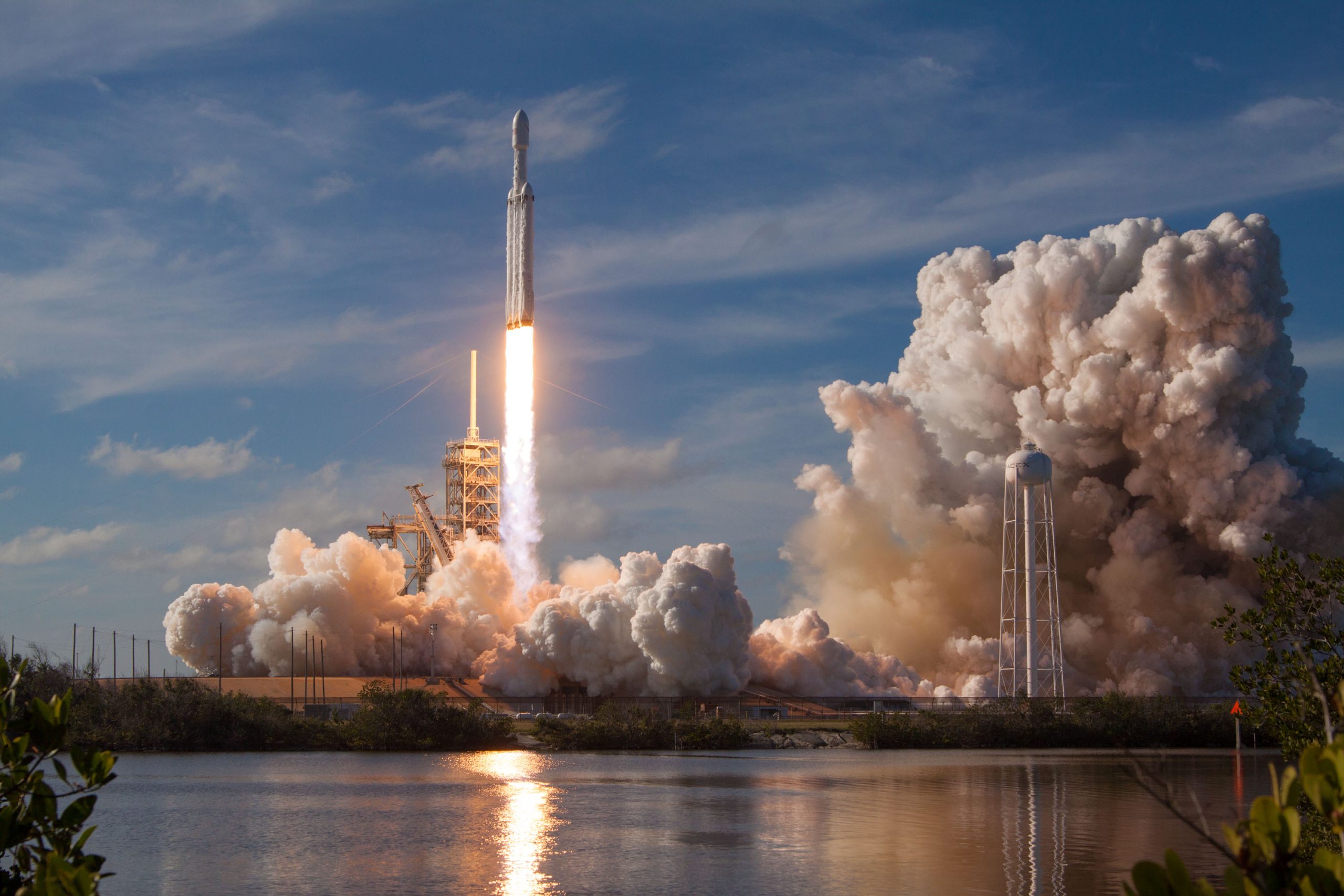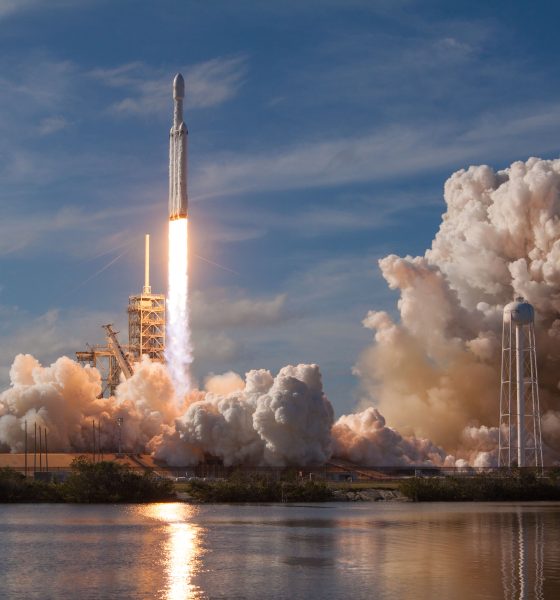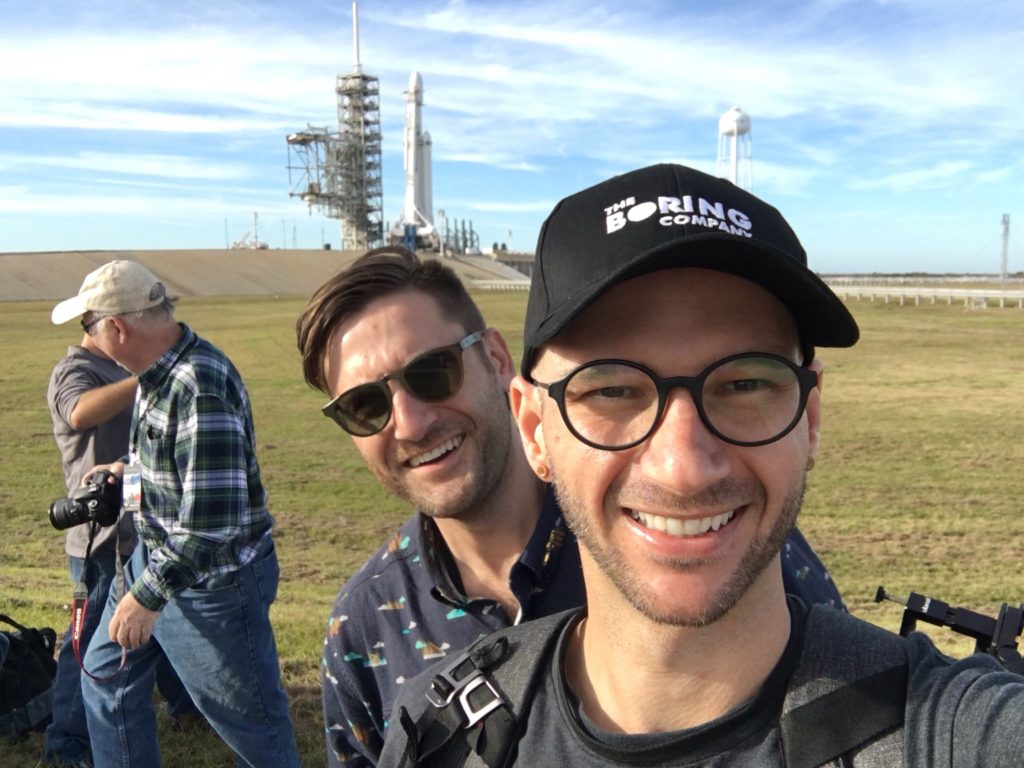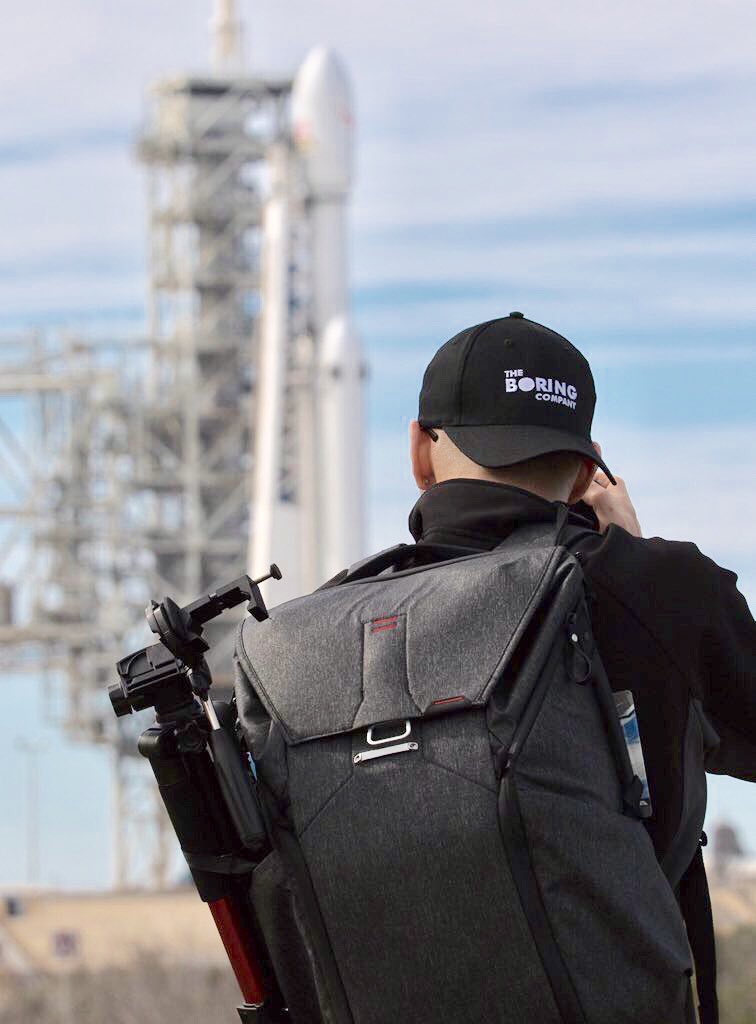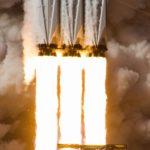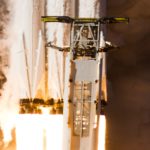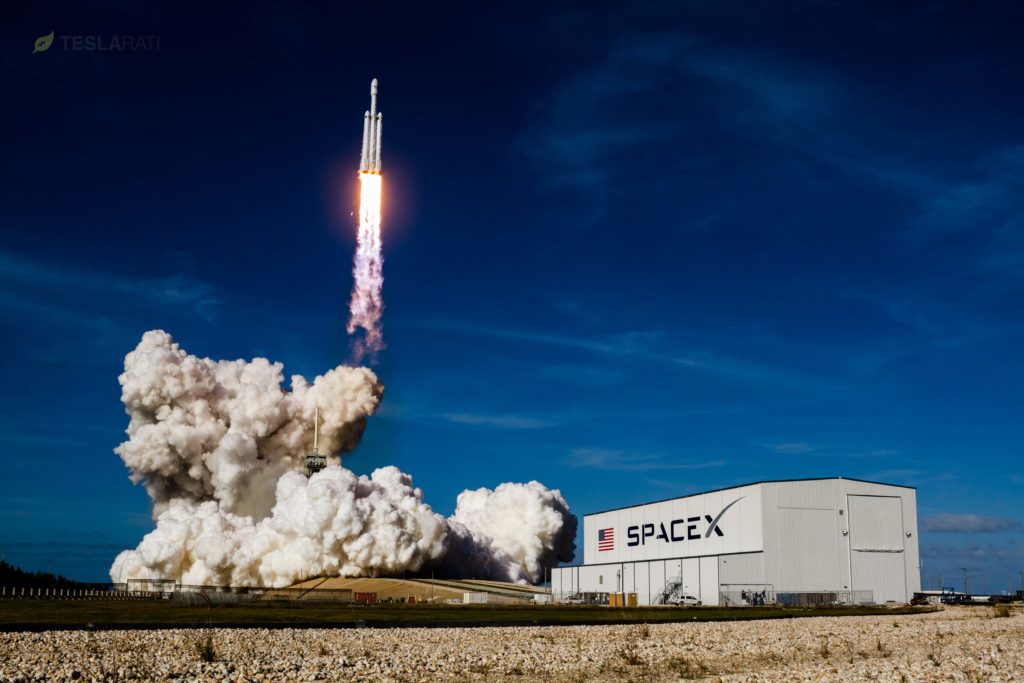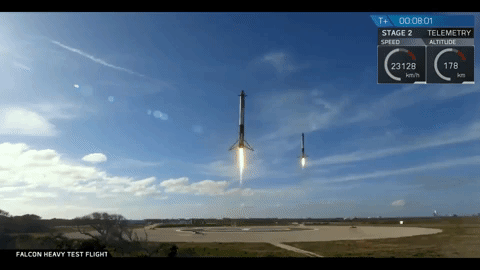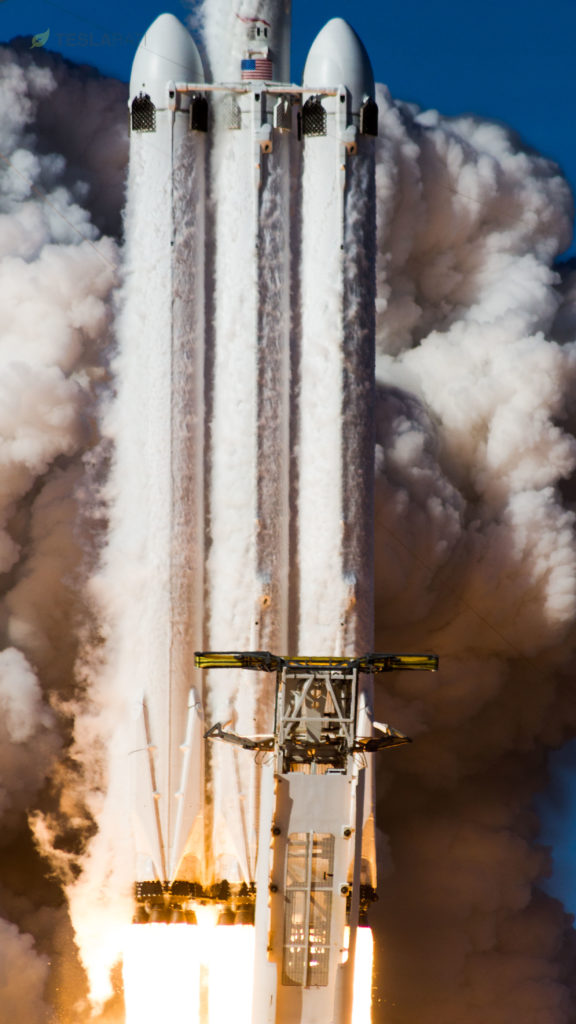As SpaceX CEO Elon Musk so succinctly put it in a post-Falcon Heavy press conference, “I’m trippin’ balls here.” Following a truly stunning inaugural launch of the heavy-lift rocket, during which two of three first stages performed a simultaneous landing back on Earth, Elon’s own Tesla Roadster began its trip to deep space and Mars.
- Tom Cross and Thaddeus Cesari photobomb Falcon Heavy ahead of its historic launch. (Tom Cross)
- Tom Cross busy at work – taking photos of Falcon Heavy, in this case! (Thaddeus Cesari)
In attendance at the historic event was Teslarati’s launch photographer, Tom Cross, who took full advantage of the opportunity by capturing some truly incredible photos. Below is a gallery of some of the best stills from both Tom’s distant viewing point and remote cameras placed at the launch pad.
Tom has managed to capture Falcon Heavy’s inaugural launch from start to finish, ranging from liftoff, booster separation, booster landings, and much more.
- Falcon Heavy clears the top of the strongback in a spectacular fashion. Two of the rocket’s three manifested missions are now for the USAF. (Tom Cross)
- Falcon Heavy is effectively three times cheaper than its closest competition. (Tom Cross)
After clearing the launch pad, something Elon Musk famously stated would be the point after which he considered the launch a success, Falcon Heavy rapidly accelerated on its way to orbit, passing one of the riskiest points of rocketry (Max-Q, peak atmospheric pressure) soon after.

Falcon Heavy roars off the pad. (Tom Cross)
Last but not least (at least regarding what’s visible from the ground), Falcon Heavy’s two side boosters successfully separated from the center booster of the rocket and began their return to Cape Canaveral. After boosting back, they reentered into the main bulk of Earth’s atmosphere and performed a truly incredibly landing, synchronized as if they were performing an elaborate aerospace ballet. Tom managed to capture these events in impressive detail from at least several miles away. Before beginning landing procedures, Falcon 9 (and Heavy) boosters effectively surf the atmosphere, using their considerable surface area to glide towards the pad while their titanium grid fins provide additional accuracy and stability.

Finally, both boosters came to a near-simultaneous stop at their separate launch pads. (Tom Cross)
Described perfectly in the post-launch press conference, Elon Musk stated that the synchronized landing was probably the coolest thing he had ever seen, and I have to agree with him on this point. With his exceptional coverage of this historic moment, Tom Cross has truly outdone himself and produced some utterly iconic photographs of Falcon Heavy’s inaugural launch.
- Falcon Heavy explodes off of Pad 39A in a spectacle of fire, Roadster in tow. (Tom Cross)
- After 11 long years, Falcon Heavy has at least truly become real. (Tom Cross)
In the meantime, Roadster, Starman, and Falcon Heavy’s upper stage (S2) are performing their own form of orbital ballet. SpaceX is likely less than an hour away from commanding the final relight of S2’s Merlin Vacuum engine, a burn that will, at last, send the eccentric payload on its way into deep space and Mars. At least during the several remaining hours of battery power, SpaceX is hosting an ongoing livestream of Roadster and its multiple camera views as it orbits the Earth and prepares to depart from Earth. Catch the stream live at the link below.
Follow along live as launch photographer Tom Cross and I cover these exciting proceedings as close to live as possible.
Teslarati – Instagram – Twitter
Tom Cross – Instagram
Eric Ralph – Twitter

News
Tesla is not sparing any expense in ensuring the Cybercab is safe
Images shared by the longtime watcher showed 16 Cybercab prototypes parked near Giga Texas’ dedicated crash test facility.

The Tesla Cybercab could very well be the safest taxi on the road when it is released and deployed for public use. This was, at least, hinted at by the intensive safety tests that Tesla seems to be putting the autonomous two-seater through at its Giga Texas crash test facility.
Intensive crash tests
As per recent images from longtime Giga Texas watcher and drone operator Joe Tegtmeyer, Tesla seems to be very busy crash testing Cybercab units. Images shared by the longtime watcher showed 16 Cybercab prototypes parked near Giga Texas’ dedicated crash test facility just before the holidays.
Tegtmeyer’s aerial photos showed the prototypes clustered outside the factory’s testing building. Some uncovered Cybercabs showed notable damage and one even had its airbags engaged. With Cybercab production expected to start in about 130 days, it appears that Tesla is very busy ensuring that its autonomous two-seater ends up becoming the safest taxi on public roads.
Prioritizing safety
With no human driver controls, the Cybercab demands exceptional active and passive safety systems to protect occupants in any scenario. Considering Tesla’s reputation, it is then understandable that the company seems to be sparing no expense in ensuring that the Cybercab is as safe as possible.
Tesla’s focus on safety was recently highlighted when the Cybertruck achieved a Top Safety Pick+ rating from the Insurance Institute for Highway Safety (IIHS). This was a notable victory for the Cybertruck as critics have long claimed that the vehicle will be one of, if not the, most unsafe truck on the road due to its appearance. The vehicle’s Top Safety Pick+ rating, if any, simply proved that Tesla never neglects to make its cars as safe as possible, and that definitely includes the Cybercab.
Elon Musk
Tesla’s Elon Musk gives timeframe for FSD’s release in UAE
Provided that Musk’s timeframe proves accurate, FSD would be able to start saturating the Middle East, starting with the UAE, next year.

Tesla CEO Elon Musk stated on Monday that Full Self-Driving (Supervised) could launch in the United Arab Emirates (UAE) as soon as January 2026.
Provided that Musk’s timeframe proves accurate, FSD would be able to start saturating the Middle East, starting with the UAE, next year.
Musk’s estimate
In a post on X, UAE-based political analyst Ahmed Sharif Al Amiri asked Musk when FSD would arrive in the country, quoting an earlier post where the CEO encouraged users to try out FSD for themselves. Musk responded directly to the analyst’s inquiry.
“Hopefully, next month,” Musk wrote. The exchange attracted a lot of attention, with numerous X users sharing their excitement at the idea of FSD being brought to a new country. FSD (Supervised), after all, would likely allow hands-off highway driving, urban navigation, and parking under driver oversight in traffic-heavy cities such as Dubai and Abu Dhabi.
Musk’s comments about FSD’s arrival in the UAE were posted following his visit to the Middle Eastern country. Over the weekend, images were shared online of Musk meeting with UAE Defense Minister, Deputy Prime Minister, and Dubai Crown Prince HH Sheikh Hamdan bin Mohammed. Musk also posted a supportive message about the country, posting “UAE rocks!” on X.
FSD recognition
FSD has been getting quite a lot of support from foreign media outlets. FSD (Supervised) earned high marks from Germany’s largest car magazine, Auto Bild, during a test in Berlin’s challenging urban environment. The demonstration highlighted the system’s ability to handle dense traffic, construction sites, pedestrian crossings, and narrow streets with smooth, confident decision-making.
Journalist Robin Hornig was particularly struck by FSD’s superior perception and tireless attention, stating: “Tesla FSD Supervised sees more than I do. It doesn’t get distracted and never gets tired. I like to think I’m a good driver, but I can’t match this system’s all-around vision. It’s at its best when both work together: my experience and the Tesla’s constant attention.” Only one intervention was needed when the system misread a route, showcasing its maturity while relying on vision-only sensors and over-the-air learning.
News
Tesla quietly flexes FSD’s reliability amid Waymo blackout in San Francisco
“Tesla Robotaxis were unaffected by the SF power outage,” Musk wrote in his post.

Tesla highlighted its Full Self-Driving (Supervised) system’s robustness this week by sharing dashcam footage of a vehicle in FSD navigating pitch-black San Francisco streets during the city’s widespread power outage.
While Waymo’s robotaxis stalled and caused traffic jams, Tesla’s vision-only approach kept operating seamlessly without remote intervention. Elon Musk amplified the clip, highlighting the contrast between the two systems.
Tesla FSD handles total darkness
The @Tesla_AI account posted a video from a Model Y operating on FSD during San Francisco’s blackout. As could be seen in the video, streetlights, traffic signals, and surrounding illumination were completely out, but the vehicle drove confidently and cautiously, just like a proficient human driver.
Musk reposted the clip, adding context to reports of Waymo vehicles struggling in the same conditions. “Tesla Robotaxis were unaffected by the SF power outage,” Musk wrote in his post.
Musk and the Tesla AI team’s posts highlight the idea that FSD operates a lot like any experienced human driver. Since the system does not rely on a variety of sensors and a complicated symphony of factors, vehicles could technically navigate challenging circumstances as they emerge. This definitely seemed to be the case in San Francisco.
Waymo’s blackout struggles
Waymo faced scrutiny after multiple self-driving Jaguar I-PACE taxis stopped functioning during the blackout, blocking lanes, causing traffic jams, and requiring manual retrieval. Videos shared during the power outage showed fleets of Waymo vehicles just stopping in the middle of the road, seemingly confused about what to do when the lights go out.
In a comment, Waymo stated that its vehicles treat nonfunctional signals as four-way stops, but “the sheer scale of the outage led to instances where vehicles remained stationary longer than usual to confirm the state of the affected intersections. This contributed to traffic friction during the height of the congestion.”
A company spokesperson also shared some thoughts about the incidents. “Yesterday’s power outage was a widespread event that caused gridlock across San Francisco, with non-functioning traffic signals and transit disruptions. While the failure of the utility infrastructure was significant, we are committed to ensuring our technology adjusts to traffic flow during such events,” the Waymo spokesperson stated, adding that it is “focused on rapidly integrating the lessons learned from this event, and are committed to earning and maintaining the trust of the communities we serve every day.”
